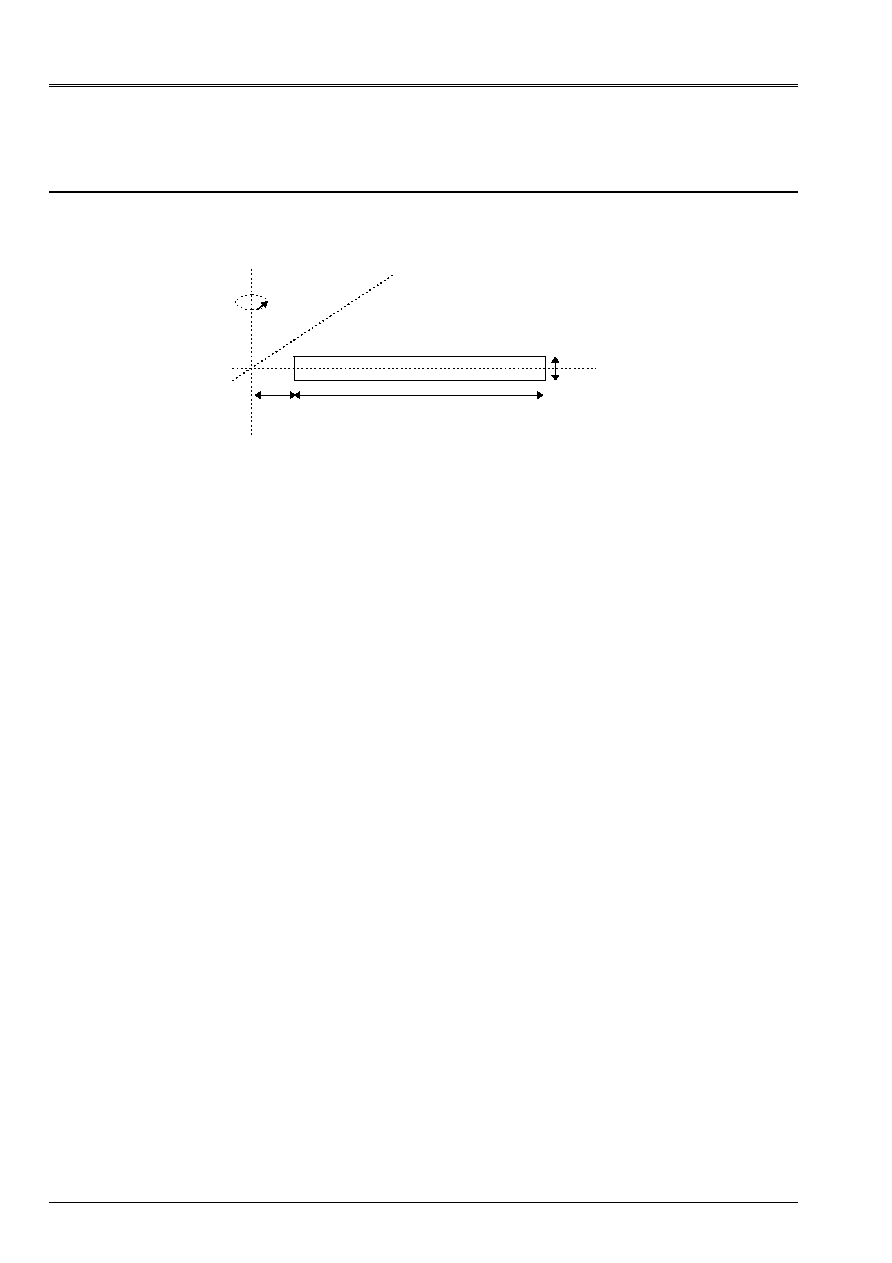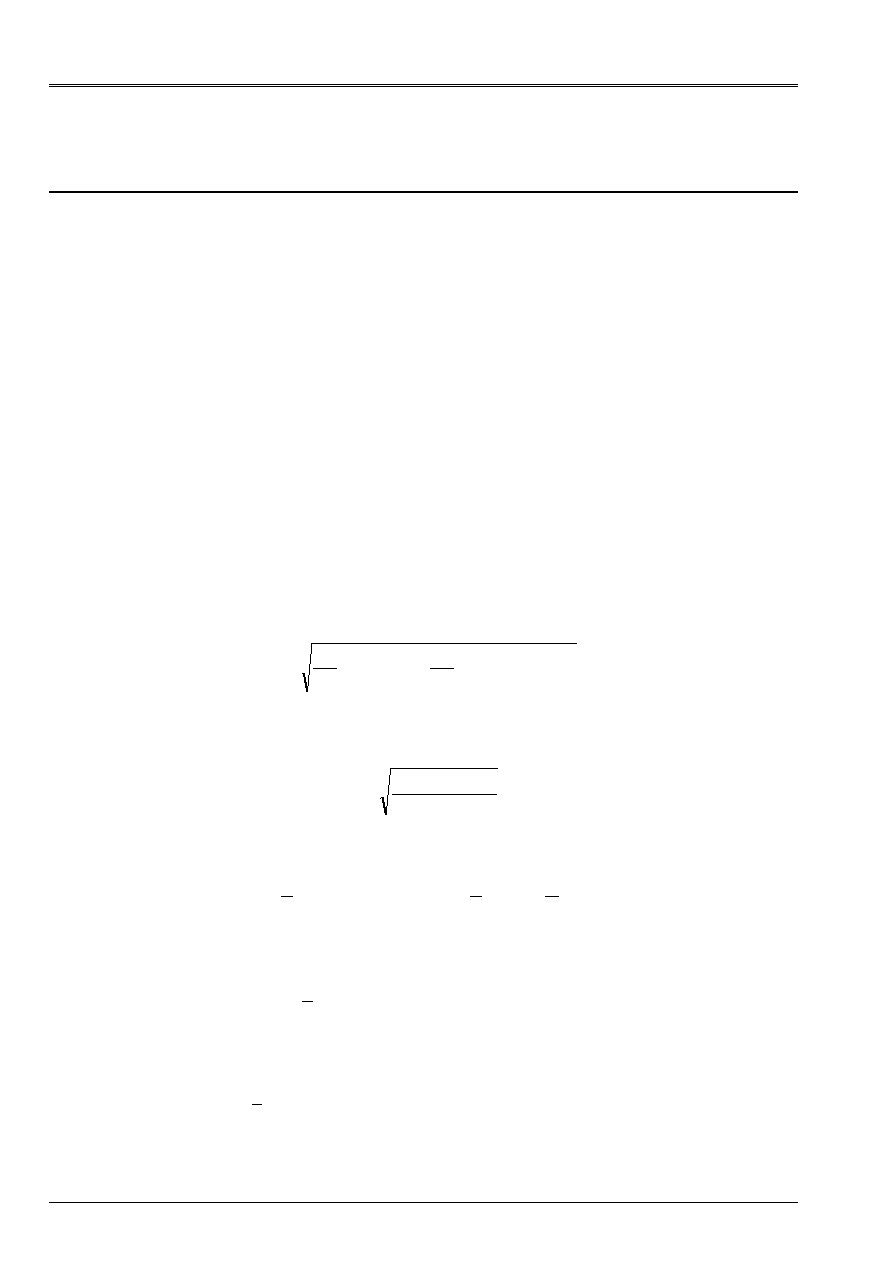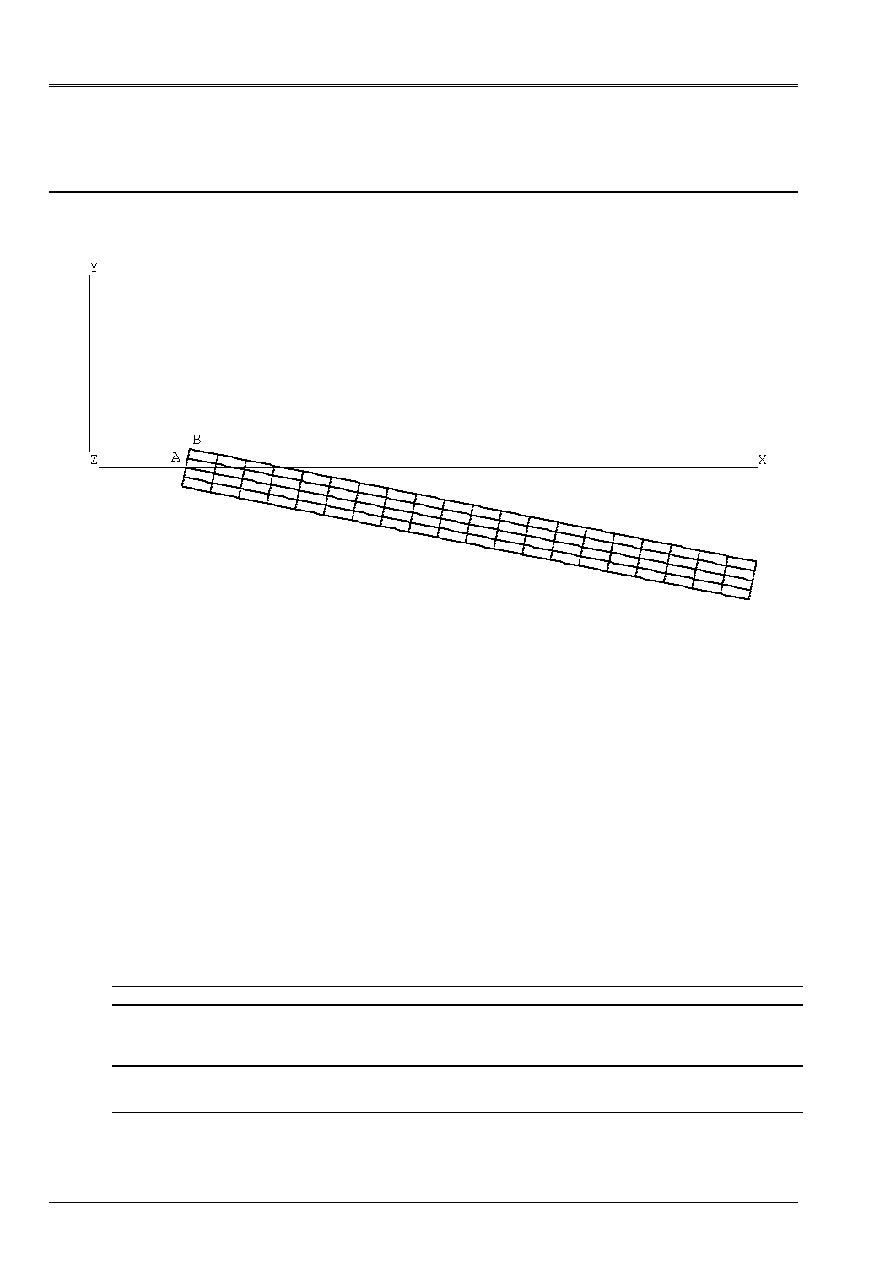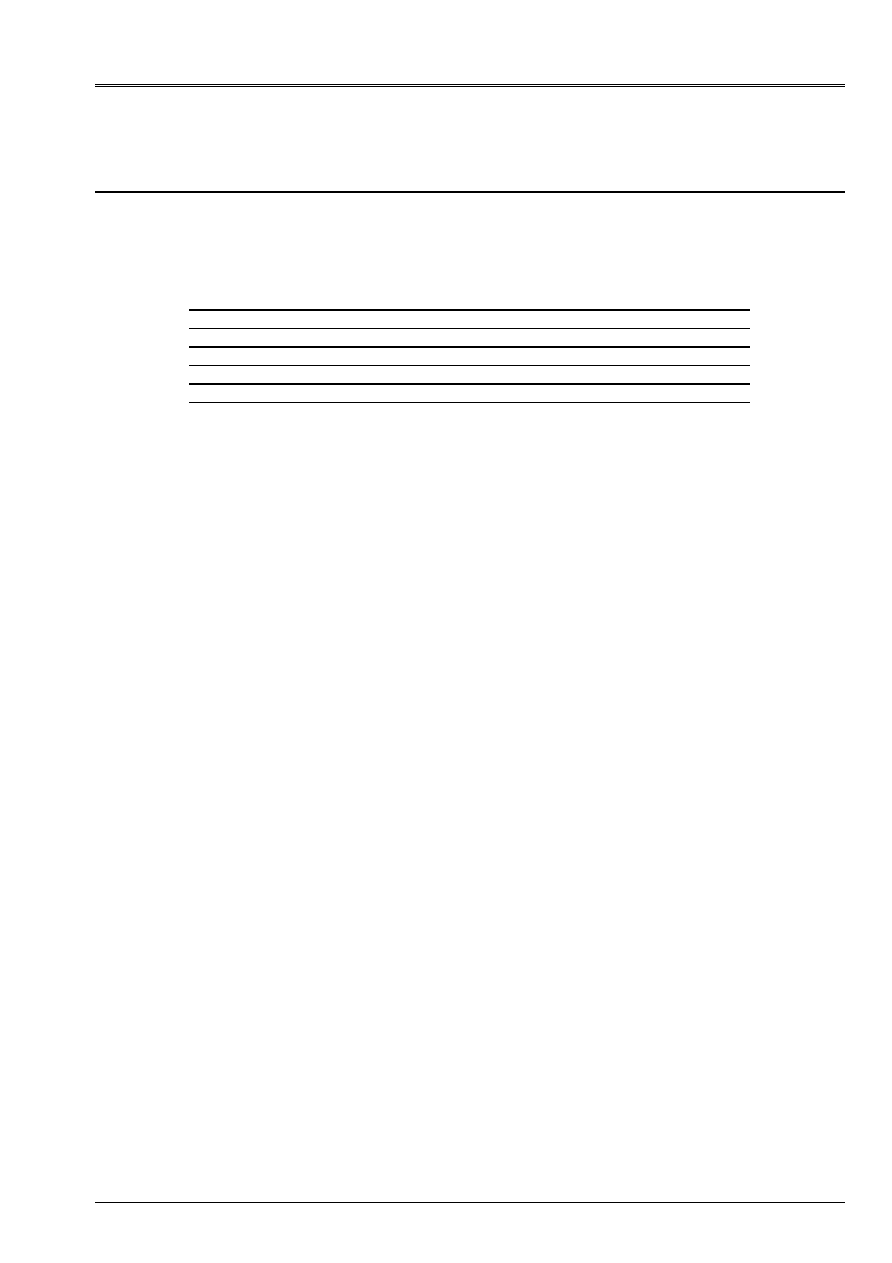
Code_Aster
®
Version
7.3
Titrate:
SDLL403 - Vibrations of a pendulum in rotation
Date:
04/10/04
Author (S):
E. BOYERE, G. ROBERT, F. SOULIE
Key
:
V2.02.403-A
Page:
1/8
Manual of Validation
V2.02 booklet: Linear dynamics of the beams
HT-66/04/005/A
Organization (S):
EDF-R & D/AMA,
SAMTECH
Manual of Validation
V2.02 booklet: Linear dynamics of the beams
V2.02.403 document
SDLL403 - Vibrations of a pendulum in rotation
Summary
The applicability of this test is the modal analysis of the structures. The studied structure is a pendulum in
rotation around an axis fixed and plunged in a field of gravity. The pendulum itself is articulated around one
center perpendicular to the axis of rotation and located at a certain distance from the aforementioned.
One is interested in the first six Eigen frequencies.
The interest of this test lies in the following aspects:
·
analyze modal with taking into account of initial stresses (geometrical stiffness)
·
analyze modal with taking into account of the centrifugal stiffening
·
important relative difference between two successive frequencies of the spectrum
Currently, the taking into account of the centrifugal stiffening is not possible that with voluminal elements.
The element used is element HEXA20 and one employs the method of Sorensen for the calculation of the frequencies
clean.
The first Eigen frequency is compared with an analytical reference. The following frequencies are
compared with numerical values obtained by a software independent of Code_Aster and using
modelings “beam” and “plane stress”.

Code_Aster
®
Version
7.3
Titrate:
SDLL403 - Vibrations of a pendulum in rotation
Date:
04/10/04
Author (S):
E. BOYERE, G. ROBERT, F. SOULIE
Key
:
V2.02.403-A
Page:
2/8
Manual of Validation
V2.02 booklet: Linear dynamics of the beams
HT-66/04/005/A
1
Problem of reference
1.1 Geometry
L
has
H
Characteristics:
Length of the pendulum
L = 0.6 m
Eccentricity
= 0.1 m has
Height of the profile
H = 0.01 m
Width of the profile
B = 0.004 m
Section
S = bh
Inertia of bending
I
Z
= bh
3
/12
1.2
Properties of materials
Young modulus
E = 7. E 10 NR/m
2
Poisson's ratio
= 0.3
Density
= 2700 kg/m
3

Code_Aster
®
Version
7.3
Titrate:
SDLL403 - Vibrations of a pendulum in rotation
Date:
04/10/04
Author (S):
E. BOYERE, G. ROBERT, F. SOULIE
Key
:
V2.02.403-A
Page:
3/8
Manual of Validation
V2.02 booklet: Linear dynamics of the beams
HT-66/04/005/A
1.3
Boundary conditions and loading
The beam is articulated at point A. the clevis pin is axis Y. the initial state of stress which
allows to carry out the geometrical calculation of the stiffnesses and centrifuges is obtained by imposing a speed
of rotation and gravity.
Acceleration of gravity
G = - 9.81 m/s ² (parallel with axis Z)
Rotational speed
= 10 rad/S
The static position of balance
0
corresponding to loading is calculated by the relation:
(
)
3
3
2
0
2
0
0
G
has
L
cos
cos
sin
=
+
One finds
0
= 11.269931365°
The conditions on displacements at point A are as follows:
U = v = W = 0;
X
=
Z
= 0
One considers moreover than the section passing by A remains rigid.
1.4 Conditions
initial
Without object in modal analysis.

Code_Aster
®
Version
7.3
Titrate:
SDLL403 - Vibrations of a pendulum in rotation
Date:
04/10/04
Author (S):
E. BOYERE, G. ROBERT, F. SOULIE
Key
:
V2.02.403-A
Page:
4/8
Manual of Validation
V2.02 booklet: Linear dynamics of the beams
HT-66/04/005/A
2
Reference solution
2.1
Method of calculation used for the reference solution
·
first Eigen frequency
The facts of the case are selected in such a way that the stiffnesses in bending and in
extension are large with respect to the stiffnesses geometrical and centrifugal. Under these conditions,
the value of the first Eigen frequency is obtained analytically by considering a pendulum
rigid.
By taking as degree of freedom the angle
between the pendulum and axis X the equation of
movement is written:
(
)
2
3
3
2
2
L
G
has
L
&&
cos
cos sin
=
-
+
The small oscillations here are considered
pendulum around a position of balance
statics
0
. By linearizing the equation of the movement in the vicinity of this position, one obtains
the equation with the small disturbances:
(
)
[
]
2
3
3
2
2
0
0
2
0
0
L
G
has
L
&&
sin
cos
cos
+
+
+
=
One deduces the pulsation from it from the first mode:
=
+
+
3
2
3
2
2
0
2
0
0
G
L
has
L
sin
cos
cos
This own pulsation can be still written in the form
()
()
I
K
K
2
+
=
with
()
(
)
()
(
)
(
)
rotation
in
inertia
centrifugal
stiffness
E
géométriqu
stiffness
3
0
2
2
3
2
0
2
0
2
2
0
2
3
1
sin
3
1
cos
3
cos
2
sin
2
1
SSL
I
SSL
K
L
has
SSL
G
SSL
K
=
-
=
+
+
=

Code_Aster
®
Version
7.3
Titrate:
SDLL403 - Vibrations of a pendulum in rotation
Date:
04/10/04
Author (S):
E. BOYERE, G. ROBERT, F. SOULIE
Key
:
V2.02.403-A
Page:
5/8
Manual of Validation
V2.02 booklet: Linear dynamics of the beams
HT-66/04/005/A
·
other Eigen frequencies
The values of reference of frequencies 2 to 6 are obtained numerically by means of
version 7 of software the SAMCEF software. Two different modelings were used: 20 elements of
deformable beam with the shearing action and 20X4 elements of membrane with 8 nodes.
results obtained in both cases are identical if one limits oneself to the first 4 digits
significant. Considering the corrections of stiffness are small with respect to the terms of stiffness
linear, one can check that frequencies 2 to 6 differ little from the analytical values
obtained for a nondeformable beam hurled with the sharp effort. In fact, the maximum variation
between the numerical and analytical values 1% do not exceed.
2.2
Results of reference
The first 5 critical loads are classified by command of increasing module.
Mode
Eigen frequency (Hz)
1 1.75556
2 100.2
3 324.0
4 674.4
5 1150.
6 1748.
2.3
Uncertainty on the solution
Analytical solution for the first frequency. Numerical solution for the others. The tolerance
estimated numerical results is 1%.
2.4 References
bibliographical
Without object.

Code_Aster
®
Version
7.3
Titrate:
SDLL403 - Vibrations of a pendulum in rotation
Date:
04/10/04
Author (S):
E. BOYERE, G. ROBERT, F. SOULIE
Key
:
V2.02.403-A
Page:
6/8
Manual of Validation
V2.02 booklet: Linear dynamics of the beams
HT-66/04/005/A
3 Modeling
With
3.1
Characteristics of modeling
The beam is with a grid by means of elements HEXA20.
Boundary conditions:
At point A such as X = 0.1, Y = 0, Z= 0:
DX = DY = DY = DRX = DRZ = 0
In addition, all the nodes of the section passing by A are rigidly dependant.
3.2
Characteristics of the mesh
A number of nodes:
1077
A number of meshs:
160 HEXA20
8
QUAD8
3.3 Functionalities
tested
Controls
AFFE_MODELE AFFE
MODELING
“3D”
AFFE_CHAR_MECA GRAVITY
ROTATION
DDL_IMPO
LIAISON_SOLIDE
CALC_MATR_ELEM OPTION
“RIGI_GEOM”
“RIGI_ROTA”
“MASS_MECA”
MODE_ITER_SIMULT METHOD
“SORENSEN”
CALC_FREQ
OPTION
PLUS_PETITE
NMAX_FREQ

Code_Aster
®
Version
7.3
Titrate:
SDLL403 - Vibrations of a pendulum in rotation
Date:
04/10/04
Author (S):
E. BOYERE, G. ROBERT, F. SOULIE
Key
:
V2.02.403-A
Page:
7/8
Manual of Validation
V2.02 booklet: Linear dynamics of the beams
HT-66/04/005/A
4
Results of modeling A
4.1 Values
tested
Frequencies in Hz
Reference mode
Code_Aster
Relative variation (%)
1 1.75556
1.7871
2.121
2
100.2 100.272 0.072
3 324.0
324.65
0.200
4
674.4 677.1 0.407
5 1150.
1157.8
0.677
6 1748.
1766.7
1.072

Code_Aster
®
Version
7.3
Titrate:
SDLL403 - Vibrations of a pendulum in rotation
Date:
04/10/04
Author (S):
E. BOYERE, G. ROBERT, F. SOULIE
Key
:
V2.02.403-A
Page:
8/8
Manual of Validation
V2.02 booklet: Linear dynamics of the beams
HT-66/04/005/A
5
Summary of the results
Good agreement with the reference solution (less than 1. % of error on all the modes safe on
first where the error is 2.2%).
This test could not be carried out with an element of beam because the calculation of the centrifugal matrix of rigidity
is not available for this type of element. In the same way, as it is not available for
discrete elements, we could not use connection 3D-beam. In order to bearing this problem, all
the nodes of surface containing point A were bound by a solid connection.







